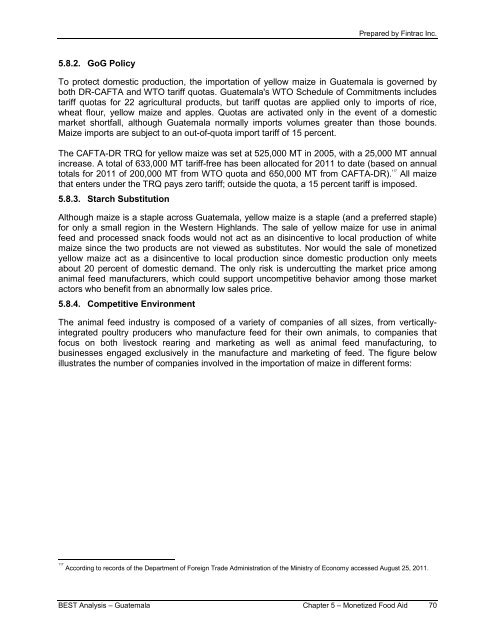usaid office of food for peace guatemala bellmon estimation
usaid office of food for peace guatemala bellmon estimation
usaid office of food for peace guatemala bellmon estimation
You also want an ePaper? Increase the reach of your titles
YUMPU automatically turns print PDFs into web optimized ePapers that Google loves.
5.8.2. GoG Policy<br />
Prepared by Fintrac Inc.<br />
To protect domestic production, the importation <strong>of</strong> yellow maize in Guatemala is governed by<br />
both DR-CAFTA and WTO tariff quotas. Guatemala's WTO Schedule <strong>of</strong> Commitments includes<br />
tariff quotas <strong>for</strong> 22 agricultural products, but tariff quotas are applied only to imports <strong>of</strong> rice,<br />
wheat flour, yellow maize and apples. Quotas are activated only in the event <strong>of</strong> a domestic<br />
market shortfall, although Guatemala normally imports volumes greater than those bounds.<br />
Maize imports are subject to an out-<strong>of</strong>-quota import tariff <strong>of</strong> 15 percent.<br />
The CAFTA-DR TRQ <strong>for</strong> yellow maize was set at 525,000 MT in 2005, with a 25,000 MT annual<br />
increase. A total <strong>of</strong> 633,000 MT tariff-free has been allocated <strong>for</strong> 2011 to date (based on annual<br />
totals <strong>for</strong> 2011 <strong>of</strong> 200,000 MT from WTO quota and 650,000 MT from CAFTA-DR). 117<br />
All maize<br />
that enters under the TRQ pays zero tariff; outside the quota, a 15 percent tariff is imposed.<br />
5.8.3. Starch Substitution<br />
Although maize is a staple across Guatemala, yellow maize is a staple (and a preferred staple)<br />
<strong>for</strong> only a small region in the Western Highlands. The sale <strong>of</strong> yellow maize <strong>for</strong> use in animal<br />
feed and processed snack <strong>food</strong>s would not act as an disincentive to local production <strong>of</strong> white<br />
maize since the two products are not viewed as substitutes. Nor would the sale <strong>of</strong> monetized<br />
yellow maize act as a disincentive to local production since domestic production only meets<br />
about 20 percent <strong>of</strong> domestic demand. The only risk is undercutting the market price among<br />
animal feed manufacturers, which could support uncompetitive behavior among those market<br />
actors who benefit from an abnormally low sales price.<br />
5.8.4. Competitive Environment<br />
The animal feed industry is composed <strong>of</strong> a variety <strong>of</strong> companies <strong>of</strong> all sizes, from verticallyintegrated<br />
poultry producers who manufacture feed <strong>for</strong> their own animals, to companies that<br />
focus on both livestock rearing and marketing as well as animal feed manufacturing, to<br />
businesses engaged exclusively in the manufacture and marketing <strong>of</strong> feed. The figure below<br />
illustrates the number <strong>of</strong> companies involved in the importation <strong>of</strong> maize in different <strong>for</strong>ms:<br />
117<br />
According to records <strong>of</strong> the Department <strong>of</strong> Foreign Trade Administration <strong>of</strong> the Ministry <strong>of</strong> Economy accessed August 25, 2011.<br />
BEST Analysis – Guatemala Chapter 5 – Monetized Food Aid 70

















